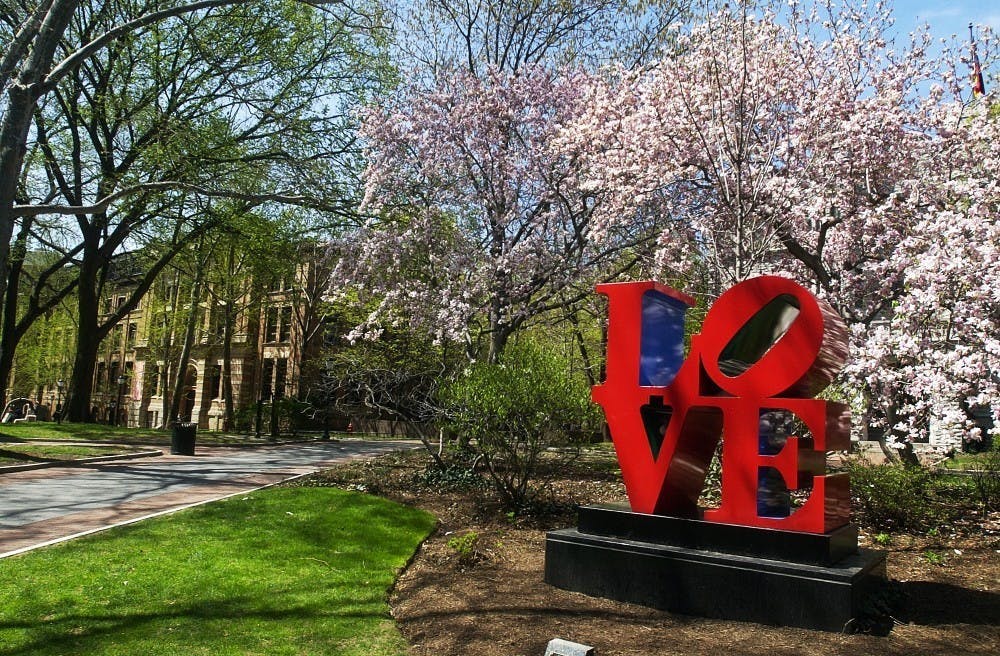Another day, another photograph of Robert Indiana’s LOVE sculpture.
Penn students are all too familiar with this cliche image: the line of visitors and prospective students all taking photos of themselves with Indiana’s iconic art piece. To them, this work of art represents the culmination of their experience here. They associate Penn with the most literal message of LOVE, and it’s hard not to when the statue exists so centrally on campus.
Just like Claus Oldenburg’s The Broken Button, LOVE is a work of Pop Art. Pop Art, which emerged in the 1950s, challenged the traditions of fine art and its contemporary, Abstract Expressionism, by re–contextualizing everyday objects as art. Think Warhol’s Campbell Soup Cans or Lichtenstein’s Whaam!, both of which appropriated imagery found in mass media into the framework of fine art. This art wrestles with the concepts of mechanicalization and commercialism in a way visual art had never before. For that reason, Pop Art is revolutionary, forever changing the visual language of all art to follow.
Critics at the time labeled Pop Art as a plague to “real art,” because of its sensationalist and gimmicky nature. Clement Greenberg’s Avant–Garde and Kitsch and Thomas Hess’s Phony Crisis are just two examples of this criticism. But the gimmick doesn’t end with the intentionality of the artist or the piece itself. Rather, the gimmick is how Indiana’s LOVE sculpture is being used at Penn. The gimmick is in how we use the vibrant, sometimes flashy nature of Pop Art to as a nice backdrop for an Instagram post rather than reckoning with the revolutionary ideology it represents.
It's this disconnect between the accessible visual nature of Pop Art (the simple compositions and recognizable elements) and the more complicated concepts it contains that makes it symbolic of superficiality. While originally it had taken “superficial” imagery, such as that of advertisements and product design, and put it in a context where we, as viewers, recognized that superficiality on face value. Now, however, it has come to be indicative of an art world (and, unfortunately, an art market) that is less and less interested with substance.
People take smiling photos of themselves with LOVE because, to them, this four letter word in the middle of campus is representative of Penn. The photo is not only proof that they were here on this campus, but that they love Penn based upon what they think it is from their brief encounter here. However, Penn isn't just the happy place that LOVE presents it as for so many visitors. Penn is more than that; it is hard work and challenging in different ways all the time. Everyday, students here are reckoning with what it means to be an adult, figuring out what they want to do with their lives, and how they can best make an impact on this world. It is not always easy, rewarding, or even “LOVE”.
It is the parallel between their perception of what it’s like to be at Penn and the debate about the superficial nature of Pop Art that is so ironic. They see the beautiful buildings and happy students that they will write about in their “Why Penn?” essays. They see the bright sculpture that spells out LOVE, not its history.
Pop Art began, in the time of Jasper Johns and Robert Rauschenberg, with elevating the ordinary—the everyday images that make up popular culture—into the realm of fine art. It brought an important debate into the art world about authenticity and authorship.
Today, however, there is no debate. No one questions if this sculpture makes sense today, on Penn’s campus, as gatekeeper for the outside world’s interactions with this university. But they should. We need to ask ourselves if this is how we want to present our university to the rest of the world. We need to question Pop Art again.

